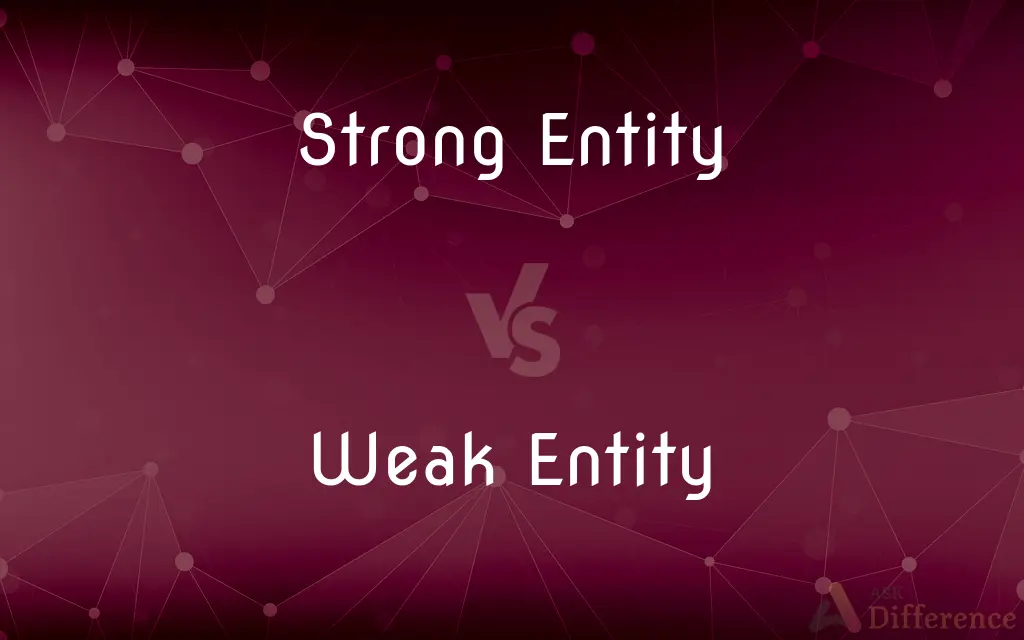Strong Entity vs. Weak Entity — What's the Difference?
By Tayyaba Rehman — Published on October 17, 2023
A Strong Entity exists independently and has a unique identifier, while a Weak Entity depends on another entity and doesn't have a unique identifier of its own.

Difference Between Strong Entity and Weak Entity
Table of Contents
ADVERTISEMENT
Key Differences
In the realm of database management and design, the term Strong Entity refers to an entity that can exist on its own without being dependent on any other entity. In essence, a Strong Entity is self-sufficient. Every instance of a Strong Entity has a unique identifier or primary key which distinguishes it from other entities. This primary key ensures that no two instances of a Strong Entity are identical, maintaining data integrity.
Conversely, a Weak Entity is one that cannot stand on its own. This means a Weak Entity's existence is reliant on another entity, typically a Strong Entity. Unlike Strong Entities, Weak Entities don't have a primary key that is unique to every instance. Instead, they possess a partial key. To uniquely identify a Weak Entity, you'd often require a combination of its partial key and the primary key of the Strong Entity it depends on.
The relationship dynamics between Strong and Weak Entities are crucial for relational database designs. For a Strong Entity, its relationships with other entities are based on its unique primary key. However, for a Weak Entity, relationships are more complex as they hinge on both the partial key of the Weak Entity and the primary key of its associated Strong Entity.
Another distinguishing factor is the representation in an Entity-Relationship (ER) diagram. Strong Entities are represented using rectangles, while Weak Entities are depicted using double rectangles. Additionally, the relationship between a Strong Entity and a Weak Entity is illustrated with a double diamond, denoting the dependency of the Weak Entity.
Comparison Chart
Independence
Exists independently
Depends on another entity
ADVERTISEMENT
Unique Identifier
Has its own primary key
Lacks a unique primary key; has a partial key
Representation in ER
Represented by a single rectangle
Represented by a double rectangle
Relationship Basis
Based on its primary key
Based on its partial key and primary key of its Strong Entity
Existence
Can exist without other entities
Requires a Strong Entity to exist
Compare with Definitions
Strong Entity
An entity that doesn't depend on another for its existence.
The 'Products' table with unique 'ProductID' serves as a Strong Entity in a sales database.
Weak Entity
An entity without a unique primary key of its own.
'TransactionItems' is a Weak Entity that leans on 'Transactions' for unique identification.
Strong Entity
A standalone entity in relational database management.
A 'Customer' with a unique 'CustomerNumber' acts as a Strong Entity in a CRM system.
Weak Entity
An entity that relies on another entity for its identification.
'OrderDetails' in a database is a Weak Entity dependent on the 'Orders' entity.
Strong Entity
An independent entity with a unique identifier.
In a database, a 'Student' with a unique 'StudentID' is a Strong Entity.
Weak Entity
An entity that has a partial key requiring another entity's key for full identification.
'Room' in a hostel database is a Weak Entity; it's uniquely identified when paired with 'Hostel'.
Strong Entity
A primary element in a database with a distinct primary key.
The 'Books' entity with a 'BookID' stands as a Strong Entity in a library system.
Weak Entity
A database component dependent on another entity's primary key for uniqueness.
'SessionSpeakers' in an event database is a Weak Entity dependent on the 'Sessions' entity.
Strong Entity
An entity characterized by its independence and unique identifier.
The 'Employees' table with individual 'EmployeeCodes' is a Strong Entity in an HR database.
Weak Entity
An element in a database that exists due to its relationship with a Strong Entity.
'Chapter' is a Weak Entity, relying on the 'Book' entity for its existence.
Common Curiosities
What is a Strong Entity?
A Strong Entity is an independent database entity with its own unique identifier or primary key.
What defines a Weak Entity?
A Weak Entity depends on a Strong Entity for its existence and doesn't have a unique primary key of its own.
Can a Weak Entity exist on its own?
No, a Weak Entity's existence is dependent on a Strong Entity.
Why might a database designer use a Weak Entity?
A Weak Entity is used when certain data elements depend on the existence of another entity, offering a structured way to represent this dependency.
Do Strong Entities always need a primary key?
Yes, Strong Entities have a primary key that uniquely identifies each instance.
Is the concept of Strong and Weak Entities specific to any database model?
No, it's a general concept but is most commonly associated with the relational database model.
How is a Strong Entity represented in an ER diagram?
In an ER diagram, a Strong Entity is shown using a single rectangle.
How do you identify a Weak Entity in a database?
A Weak Entity is identified using a combination of its partial key and the primary key of the Strong Entity it depends on.
What's a primary key in context to a Strong Entity?
It's a unique identifier that differentiates instances of a Strong Entity.
Can a database have only Strong Entities?
Yes, it's possible for a database to consist only of Strong Entities, without any Weak Entities.
Can a Weak Entity have another Weak Entity dependent on it?
Yes, but this can lead to complex relationship chains and might be avoided for clarity and simplicity.
What's a partial key for a Weak Entity?
A partial key identifies instances of a Weak Entity but requires a Strong Entity's primary key for complete uniqueness.
In relational databases, why is the distinction between Strong and Weak Entities important?
This distinction ensures data integrity, proper relationships, and efficient data retrieval.
Can a Weak Entity be converted into a Strong Entity?
Theoretically, with proper restructuring and by providing a unique identifier, a Weak Entity can be made a Strong Entity.
How are relationships between Strong and Weak Entities depicted?
In ER diagrams, relationships between them are shown using double diamonds.
Share Your Discovery

Previous Comparison
Helium Atom vs. Alpha Particle
Next Comparison
Vowels vs. ConsonantsAuthor Spotlight
Written by
Tayyaba RehmanTayyaba Rehman is a distinguished writer, currently serving as a primary contributor to askdifference.com. As a researcher in semantics and etymology, Tayyaba's passion for the complexity of languages and their distinctions has found a perfect home on the platform. Tayyaba delves into the intricacies of language, distinguishing between commonly confused words and phrases, thereby providing clarity for readers worldwide.
















































